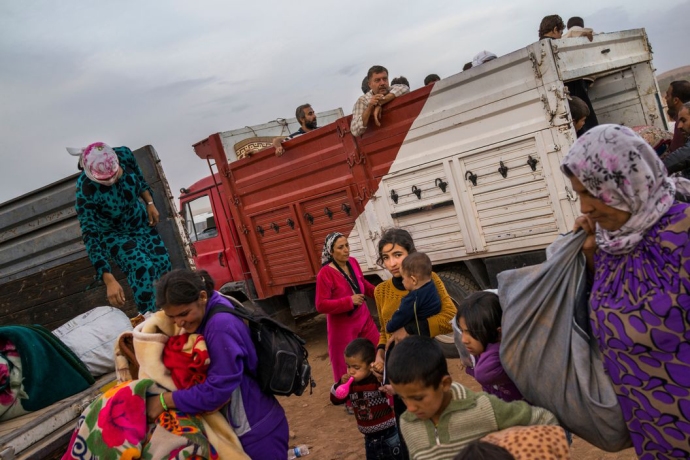
16 Dec 2014
Few experiences are more haunting than visiting a refugee camp in the middle of winter. You walk the rows between the tents, peering in here and there, finding men and women wrapped in blankets, huddled round lanterns, each face wearing the unforgettable look of a person who has lost control of his life. The children are shivering. You wonder, inevitably, how things could get any worse. On December 1st, the World Food Programme (W.F.P.), announced that it was suspending its operations to feed one million seven hundred thousand Syrian refugees—scattered across Lebanon, Turkey, Jordan, and Egypt—because it had run out of money. (The program is under the auspices of the U.N., but funded entirely by voluntary donations.) Under the program, Syrian families received the equivalent of a dollar a person each day to buy food at local shops. This operation cost sixty-four million dollars a month, and, while governments and private donors had helped to fund it throughout most of 2014, there was no longer enough money to carry on. This was “disastrous,” the Programme said in a statement. Winter, indeed. Agencies dedicated to providing humanitarian relief, like the World Food Programme and private organizations, like the International Rescue Committee (I.R.C.), are always pleading for money. From a distance, it’s easy to assume that they always get it, that a government or a wealthy donor will eventually write the check that allows them to continue their work. Not so: each year, relief organizations suspend or curtail aid because they run out of cash. “The majority of our programs end because the money runs out, not because the need is gone,” David Miliband, the president of the I.R.C., which has twelve thousand relief workers in forty countries, told me. In Zimbabwe, where at least a half million people need food, the W.F.P. is closing three of its four field offices at the end of the month. It has already reduced rations for malnourished children, pregnant women, and people with H.I.V. and with tuberculosis. When the W.F.P. announced that it was suspending its voucher program for Syrian refugees, it also started a campaign to get it going again, which spurred an outpouring of support. Some fourteen thousand people from a hundred and fifty-eight countries sent money, contributing a total of $1.8 million. A number of Western and Middle Eastern governments (including the United States, the W.F.P.’s largest donor) came to the rescue, giving the W.F.P. a total of eighty-eight million dollars, more than enough to restart the Syria program and run it for another month. This may sound like a story with a happy ending, but it’s not. The W.F.P won’t be able to get the program going again in most locations until the middle of the month. That means that hundreds of thousands of people, largely unable to feed themselves, are going without the program’s help for up to two weeks. Just as important, the eighty-eight million dollars will be gone before the end of January. Governments will likely step in and provide more money, but they don’t have to, and there’s no guarantee that they will. “We have to worry about January, we have to worry about February, we have to worry about March,” Bettina Luescher, a W.F.P. spokesperson, said. The travails of the refugees are emblematic of the larger humanitarian catastrophe unfolding in Syria, where the civil war will soon enter its fifth year. As many as two hundred thousand people are dead, and some ten million people—more than half the population—are homeless. Those numbers may be difficult to fully comprehend, but the world’s relief workers are trying. The W.F.P. estimates that it is feeding more than four million people inside Syria. The I.R.C., one of the world’s largest private relief organizations, is employing some twenty-five hundred people in and around the country to run everything from medical clinics to schools. Even delivering food to people inside Syria is a nightmare. Food convoys have been blocked and attacked by both the government of Bashar al-Assad and the rebels. The city of Homs was under siege by the government for more than six hundred days, and during that time no humanitarian-aid convoys were allowed to pass; the siege finally lifted in May. Luescher, the W.F.P. spokesperson, said that there are still several areas in Syria where it is too dangerous to deliver food, including Deir ez-Zor and Ar-Raqqa, which are under the control of ISIS. About six hundred thousand people there need food, she said. As vast as the crisis in Syria is, it’s only one of several across the globe. In Iraq, South Sudan, and the Central African Republic, huge numbers of refugees are on the move; in West Africa, there is the outbreak of Ebola. Apart from watching all this, what can you do? You can send money. I’ve seen the work of both the World Food Programme and the I.R.C. up close, and I can tell you that both make a difference. The W.F.P. isn’t the only organization making food deliveries in Syria. Last week, both ISIS and Jabhat al-Nusra, Al Qaeda’s Syrian franchise, published photographs showing their soldiers distributing food to “good Muslims” in areas under their control. ISIS’s photographs were accompanied by another series, showing a man, recently convicted of adultery, being stoned to death.

 عربي
عربي